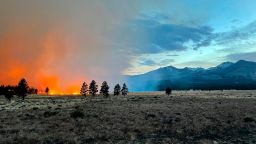Critically dry weather conditions continue to fuel fires across the Southwest, bringing yet another week of fire danger.
It has been an extraordinarily busy start to the fire year in the South and Southwest, with more than 19,000 wildfires reported through Tuesday, according to the National Interagency Fire Center.
This is the highest number of fires at this time of the year in any year in the past decade, burning a total of 827,000 acres, more than 30% above average.
These numbers will likely climb higher over the course of this week, given the dry forecast over a region already plagued with extreme and exceptional drought conditions.
“Everybody’s kind of tired of hearing windy conditions, dry conditions, unstable conditions,” Todd Shoemake with the National Weather Service (NWS) in Albuquerque told CNN, adding that “it is repetitive doing that day in and day out.”
This week’s critical fire risk comes as just one of many that this region has experienced over the last several weeks.

There are currently 11 large wildfires burning across the Southwest and Southern Plains regions, including the Tunnel Fire near Flagstaff, Arizona, which had ballooned to more than 19,000 acres as of Wednesday afternoon.
In the near future, there’s little to no relief as “fire conditions remain ripe across the Southwest, Front Range, and southern High Plains through the end of the week,” according to the Weather Prediction Center (WPC).
Fueling the flames
Today, over 8 million people are under fire alerts with areas across New Mexico, western Texas, and portions of Nebraska and Wyoming under critical fire risk – level 2 of 3.
On Thursday, the critical risk shifts toward the southern High Plains, including parts of the Texas Panhandle.
This comes as a result of extremely dry conditions, low humidity, gusty winds and near record-setting high temperatures.
“In terms of temperatures, summer-like warmth is on tap in the Southwest and the southern High Plains through Thursday,” the WPC said, noting many high-temperature records may be broken.
However, the risk doesn’t end there.
“While critically dry and windy conditions are expected to be widespread Thursday-Saturday, Friday appears to be particularly volatile,” the Storm Prediction Center (SPC) warns.
As a low-pressure system moves out of the area later this week, wind gusts will peak Friday at 50-70 miles per hour.
These extremely strong winds are “expected to support Extremely Critical conditions across central and eastern New Mexico into eastern Colorado Friday afternoon,” according to the SPC.
With all the atmospheric ingredients present for optimal fire weather, that leaves just one more important factor: dry fuels.
Last year’s monsoon season brought decent rainfall across the region, causing fuels such as grasses and weeds to “shoot up,” according to Shoemake.
“You love to see the rainfall when it happens but it does cause vegetation to grow quickly like that, and then you know that dry period is coming on the heels of that can be very concerning,” Shoemake said.
Now that dry conditions are prevalent across the Southwest again, the fuels are a ticking time bomb for wildfires, making it easy for them to grow and spread.
Unusual timing raises concern
Week after week of widespread fire risk for the Plains and Southwest this early in the year is not normal.
“We’re used to dealing with this maybe late May into June and even the first week of July,” Shoemake said, “But this is very early for us.”
In addition to arriving early, the fire weather and its primary ingredients have maintained a persistent chokehold on the region.
“Seeing the widespread fire activity that we’ve already seen and then couple that with just really dry conditions, severe drought conditions, everything’s just kind of culminated together for a pretty long stretch of fire weather,” Shoemake noted.
Although exhausting for the people living in these regions, meteorologists with the NWS continue to urge people to stay alert and do their part to prevent wildfires.
“Any fires that develop will spread rapidly and be hard to control,” the NWS Albuquerque warns, emphasizing the importance of taking all precautions to prevent a fire.






